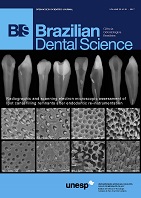Alternative therapies for denture stomatitis treatment: in vivo experimental model in rats
DOI:
https://doi.org/10.14295/bds.2017.v20i1.1368Abstract
Background: Denture stomatitis (DS) is a multifactorial condition that commonly affects denture users and is mainly caused by Candida albicans. Due to the toxic effects of antifungal therapy, new therapies for DS are claimed. Objective: The aim of the study was to evaluate the efficacy of aqueous extract of Buchenavia tomentosa and sodium bicarbonate against C. albicans in a model of DS in rats. Material and Methods: An acrylic resin device simulating a denture base was fixed covering the palate of forty-eight male rats followed by candidiasis induction. Rats were divided into 4 groups (n=12): Control, sodium bicarbonate, B. tomentosa and nystatin (positive control). Each group was subdivided according to the period of treatment; 24 hours (n=6) and 48 hours (n=6). Animals were sacrificed and had their devices removed for C. albicans counts and SEM analysis. The palate mucosa was removed and processed for histopathologic analysis. Results: After 24 hours of treatment, both B. tomentosa and nystatin groups reduced significantly C. albicans counts when compared to control (nystatin x control, p<0.01; B. tomentosa x control, p=0.03). The results were confirmed by the histologic analysis. Conclusion: Both the aqueous extract of B. tomentosa and sodium bicarbonate was able to significantly decrease C. albicans counts in an experimental model of DS.
Downloads
Downloads
Published
How to Cite
Issue
Section
License
Brazilian Dental Science uses the Creative Commons (CC-BY 4.0) license, thus preserving the integrity of articles in an open access environment. The journal allows the author to retain publishing rights without restrictions.
=================




























